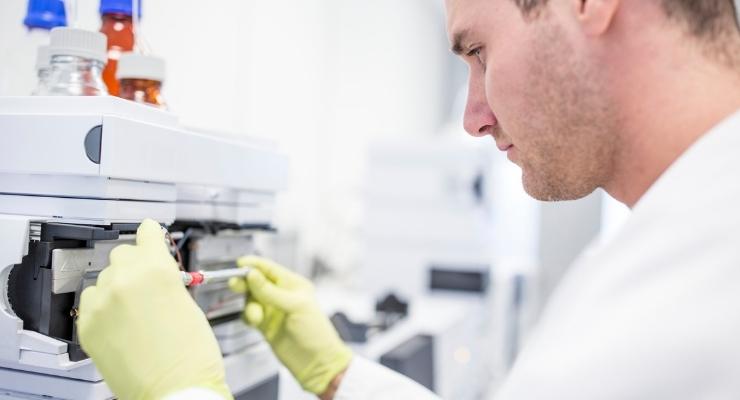07.05.22
Third-party testing company Alkemist Labs reports that its clients had been getting pesticides tests for their products from other third-party labs which were not as comprehensive as they had assumed.
The tests, specifically, were USP (United States Pharmacopoeia) <561> tests, which encompass articles of botanical origin. In terms of pesticides, it addresses 70 reportable compounds covering 121 individual analytes. Alkemist tests for the full USP panel, which requires conducting four separate assays using three different instruments: one run each of UPLC-MS/MS, APGC-MS/MS, and two runs of GC-MS/MS.
“Ninety eight percent of the compounds tested for UPLC-MS/MS and the APGC-MS/MS; the other 2% requires two additional analytical runs,” said Anthony Fontana, PhD, lab director for Alkemist Labs. “What we have learned is that a lot of labs skip those, quite possibly because of the time and processing you need to run it. You are changing over the same instrument twice, each time to search for one more analyte, which can take half a day. Skipping these two runs only omits two analytes from an already lengthy report, so they may be easily overlooked.”
Alkemist Labs said that it advises companies to carefully check their pesticide testing reports to ensure that results include inorganic bromide and dithiocarbamates measured and reported as carbon disulfide (CS2). If these compounds are omitted, then USP <561> pesticides testing is incomplete. From the reports Alkemist has seen, some certificates of authenticity are transparent about the missing compounds, but others are not. Sometimes the cost to the manufacturer doubles if those last two analytes are added to the test run.
Another practice Alkemist has seen is the use of the phrase “USP <561> modified.” Usually the use of “modified” in relations to USP means that newer instrumentation or column technology is being used than described in the USP chapter. However, USP <561> is not a detailed analytical method, but rather a table of pesticides that must be tested to confirm they are below the listed thresholds. So showing USP <561> modified on a report appears to indicate that some pesticides are not being tested for at all.
Depending on how a company has set their specifications, this may lead them to be out of compliance with current Good Manufacturing Practices, Alkemist reports. Additionally, this error could be caught in an audit if they have set a spec they are not testing to. Additionally, there comes a risk of losing consumer trust, and a safety risk due to pesticides which have not been screened for.
“I understand why some labs may use this practice, which would necessarily make testing more expensive, but it’s misleading,” said Elan Sudberg, CEO of Alkemist Labs. “The industry has to be better than that.”
The tests, specifically, were USP (United States Pharmacopoeia) <561> tests, which encompass articles of botanical origin. In terms of pesticides, it addresses 70 reportable compounds covering 121 individual analytes. Alkemist tests for the full USP panel, which requires conducting four separate assays using three different instruments: one run each of UPLC-MS/MS, APGC-MS/MS, and two runs of GC-MS/MS.
“Ninety eight percent of the compounds tested for UPLC-MS/MS and the APGC-MS/MS; the other 2% requires two additional analytical runs,” said Anthony Fontana, PhD, lab director for Alkemist Labs. “What we have learned is that a lot of labs skip those, quite possibly because of the time and processing you need to run it. You are changing over the same instrument twice, each time to search for one more analyte, which can take half a day. Skipping these two runs only omits two analytes from an already lengthy report, so they may be easily overlooked.”
Alkemist Labs said that it advises companies to carefully check their pesticide testing reports to ensure that results include inorganic bromide and dithiocarbamates measured and reported as carbon disulfide (CS2). If these compounds are omitted, then USP <561> pesticides testing is incomplete. From the reports Alkemist has seen, some certificates of authenticity are transparent about the missing compounds, but others are not. Sometimes the cost to the manufacturer doubles if those last two analytes are added to the test run.
Another practice Alkemist has seen is the use of the phrase “USP <561> modified.” Usually the use of “modified” in relations to USP means that newer instrumentation or column technology is being used than described in the USP chapter. However, USP <561> is not a detailed analytical method, but rather a table of pesticides that must be tested to confirm they are below the listed thresholds. So showing USP <561> modified on a report appears to indicate that some pesticides are not being tested for at all.
Depending on how a company has set their specifications, this may lead them to be out of compliance with current Good Manufacturing Practices, Alkemist reports. Additionally, this error could be caught in an audit if they have set a spec they are not testing to. Additionally, there comes a risk of losing consumer trust, and a safety risk due to pesticides which have not been screened for.
“I understand why some labs may use this practice, which would necessarily make testing more expensive, but it’s misleading,” said Elan Sudberg, CEO of Alkemist Labs. “The industry has to be better than that.”




























